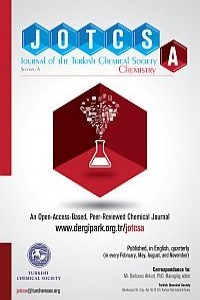Synthesis and Chemical Characterization of Alkyd Resins Using Maleic and Phthalic Anhydrides and Seed oil of Luffa aegyptiaca
Synthesis and Chemical Characterization of Alkyd Resins Using Maleic and Phthalic Anhydrides and Seed oil of Luffa aegyptiaca
Alkyd resin, Sponge seed oil, Spectroscopic Characterization, phthalic anhydride, maleic anhydride,
___
- 1. Akintayo E. Characteristics and composition of Parkia biglobbossa and Jatropha curcas oils and cakes. Biores technol. 2004;92(3):307-10.
- 2. Stephens J. Gourd Luffa-Luffa cylindrical, Luffaaegyptica and Luffaacutangula. J Hortic Sci Univ Florida. 2003;3:19-21.
- 3. Udo GJ, Etesin UM, Awaka-Ama JJ, Nyong AE, Uwanta EJ. GCMS and FTIR Spectroscopy Characterization of Luffa Cylindrica Seed Oil and Biodiesel Produced from the oil. Commun Phys Sci. 2010;5(1,2,3): 378-90.
- 4. Elemo GN, Elemo BO, Erukainure OL. Characterization of sponge gourd (Luffa aegyptiaca Mill.) seed oil. J Trop Agric. 2011;49:128-30.
- 5. Oli C, Onuegbu T, Ezeudu E. Proximate composition, characterization and spectroscopic analysis of Luffa aegyptiaca Seed. Int J Life Sci Biotechnol Pharma Res. 2014;3(4):194.
- 6. Khot SN, Lascala JJ, Can E, Morye SS, Williams GI, Palmese GR, et al. Development and application of triglyceride‐based polymers and composites. J Appl Polym Sci. 2001;82(3):703-23.
- 7. Harry-O'Kuru R, Holser R, Abbott T, Weisleder D. Synthesis and characteristics of polyhydroxy triglycerides from milkweed oil. Ind Crop Prod. 2002;15(1):51-8.
- 8. Atolani O, Olabiyi ET, Issa AA, Azeez HT, Onoja EG, Ibrahim SO, et al. Green synthesis and characterisation of natural antiseptic soaps from the oils of underutilised tropical seed. Sust Chem Pharm. 2016;4:32-9.
- 9. Zubair MF, Atolani O, Ibrahim SO, Oguntoye OS, Abdulrahim HA, Oyegoke RA, et al. Chemical and biological evaluations of potent antiseptic cosmetic products obtained from Momordica charantia seed oil. Sust Chem Pharm. 2018;9:35-41.
- 10. Otabor G, Ifijen I, Mohammed F, Aigbodion A, Ikhuoria E. Alkyd resin from rubber seed oil/linseed oil blend: a comparative study of the physiochemical properties. Heliyon. 2019;5(5):e01621.
- 11. Kyenge B, Anhwange B, Ageh J, Igbum G. Comparative analysis of soybean seed oil modified alkyd resin and epoxidized soybean seed oil modified alkyd resin. Int J Modern Org Chem. 2012;1(2):66-71.
- 12. Bora MM, Gogoi P, Deka DC, Kakati DK. Synthesis and characterization of yellow oleander (Thevetia peruviana) seed oil-based alkyd resin. Ind Crop Prod. 2014;52:721-8.
- 13. Nway N, Mya M. Manufacture of alkyd resin from castor oil. Proc Word Acad Sci Eng Technol. 2008;36:928-34.
- 14. Dhole G, Gunasekaran G, Singh S, Vinjamur M. Smart corrosion sensing phenanthroline modified alkyd coatings. Prof Org Coat. 2015;89:8-16.
- 15. Jain RM, Mody K, Mishra A, Jha B. Physicochemical characterization of biosurfactant and its potential to remove oil from soil and cotton cloth. Carbohyd polym. 2012;89(4):1110-6.
- 16. Hlaing NN, Oo MM. Manufacture of alkyd resin from castor oil. World Acad Sci Eng Technol. 2008;48:155-61.
- 17. Patil DM, Phalak GA, Mhaske ST. Design and synthesis of bio-based epoxidized alkyd resin for anti-corrosive coating application. Iran Polym J. 2018;27(10):709-19.
- 18. Ikhuoria EU, Aigbodion AI, Okieimen FE. Enhancing the quality of alkyd resins using methyl esters of rubber seed oil. Trop J Pharm Res. 2004;3(1):311-7.
- 19. Spasojević P, Panić V, Džunuzović J, Marinković AD, Woortman A, Loos K, et al. High performance alkyd resins synthesized from postconsumer PET bottles. RSC Adv. 2015;5(76):62273-83.
- 20. Ramli MF, Gan SN, Lim WH, Phang SW. Application of a palm oil-based alkyd for the improvement of polyaniline properties. Polym Polym Compos. 2017;25(7):537-44.
- 21. Mahdavi R, Ashraf Talesh S. Experimental Investigation of Enhanced Self cleaning Properties of Alkyd Resin by Modified Zinc Oxide Nanoparticles. Nanoscale. 2018;5(1):73-81.
- 22. Issam A, Cheun C. A study of the effect of palm oil on the properties of a new alkyd resin. Malay Polym J. 2009;4(1):42-9.
- 23. Islam MR, Beg MDH, Jamari SS. Alkyd based resin from non-drying oil. Procedia Eng. 2014;90:78-88.
- 24. Kanai T, Mahato T, Kumar D. Synthesis and characterization of novel silicone acrylate–soya alkyd resin as binder for long life exterior coatings. Prog Org Coat. 2007;58(4):259-64.
- 25. Chiplunkar PP, Pratap AP. Utilization of sunflower acid oil for synthesis of alkyd resin. Prog Org Coat. 2016;93:61-7.
- 26. Uschanov P, Heiskanen N, Mononen P, Maunu SL, Koskimies S. Synthesis and characterization of tall oil fatty acids-based alkyd resins and alkyd–acrylate copolymers. Prog Org Coat. 2008;63(1):92-9.
- Başlangıç: 2014
- Yayıncı: Türkiye Kimya Derneği
Structural Properties, Photoluminescence, and Judd-Ofelt Parameters of Eu3+- Doped CoNb2O6 Phosphor
Mustafa İLHAN, Lütfiye Feray GÜLERYÜZ, Mete Kaan EKMEKCİ
Synthesis, Characteristics and Applications of Graphene Composites: A Survey
Biswajit DALAİ, Biswajit PATRA, Niharika DAS, Ruturaj SAHOO, Dipak Kumar SAHOO, Chhatrapati PARİDA, Sarat Kumar DASH
Marili Funmilayo ZUBAİR, Sulyman Olalekan IBRAHİM, Kenneth STEPHEN, Abdulmumeen Amao HAMİD, Olamilekan IBUKUN, Olubunmi ATOLANİ
Cemil DIZMAN, Elif CERRAHOĞLU KAÇAKGİL, Levent BABAYİĞİT, Caner ARAR
